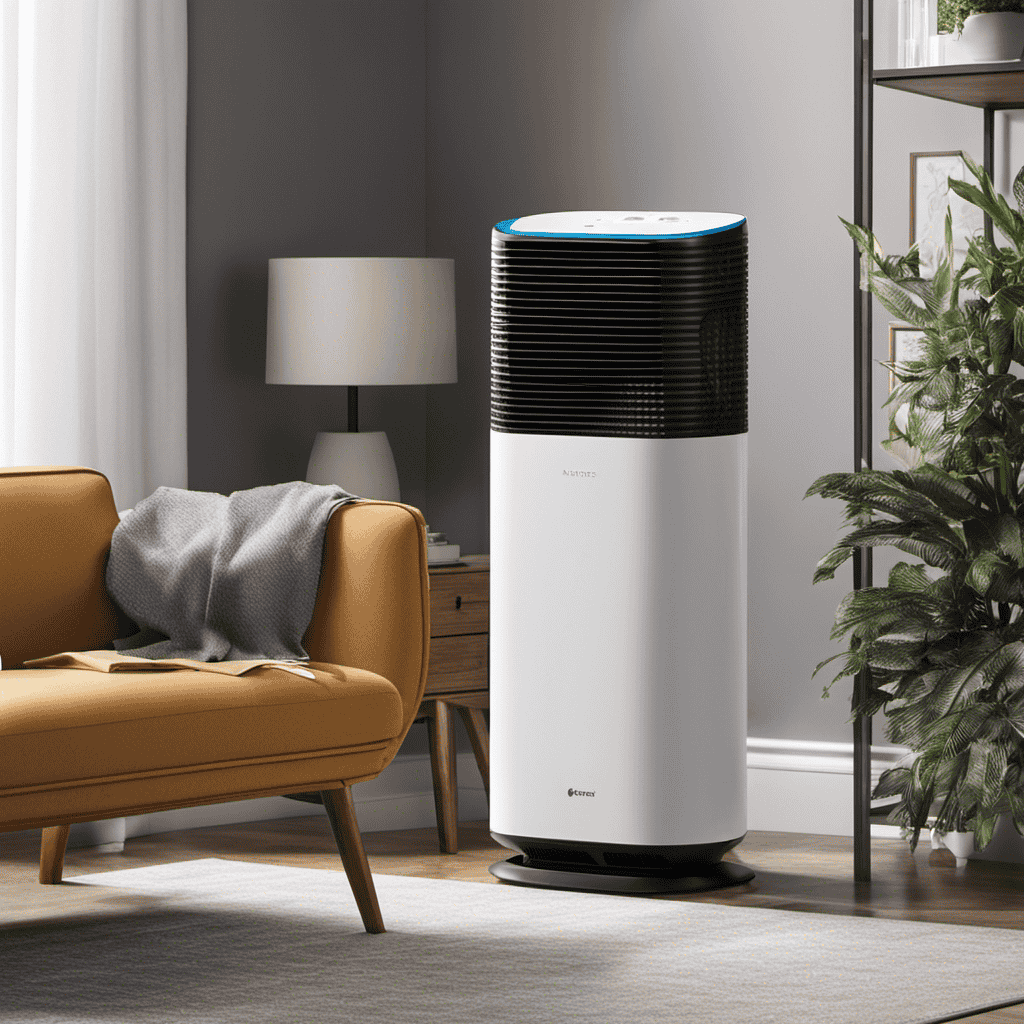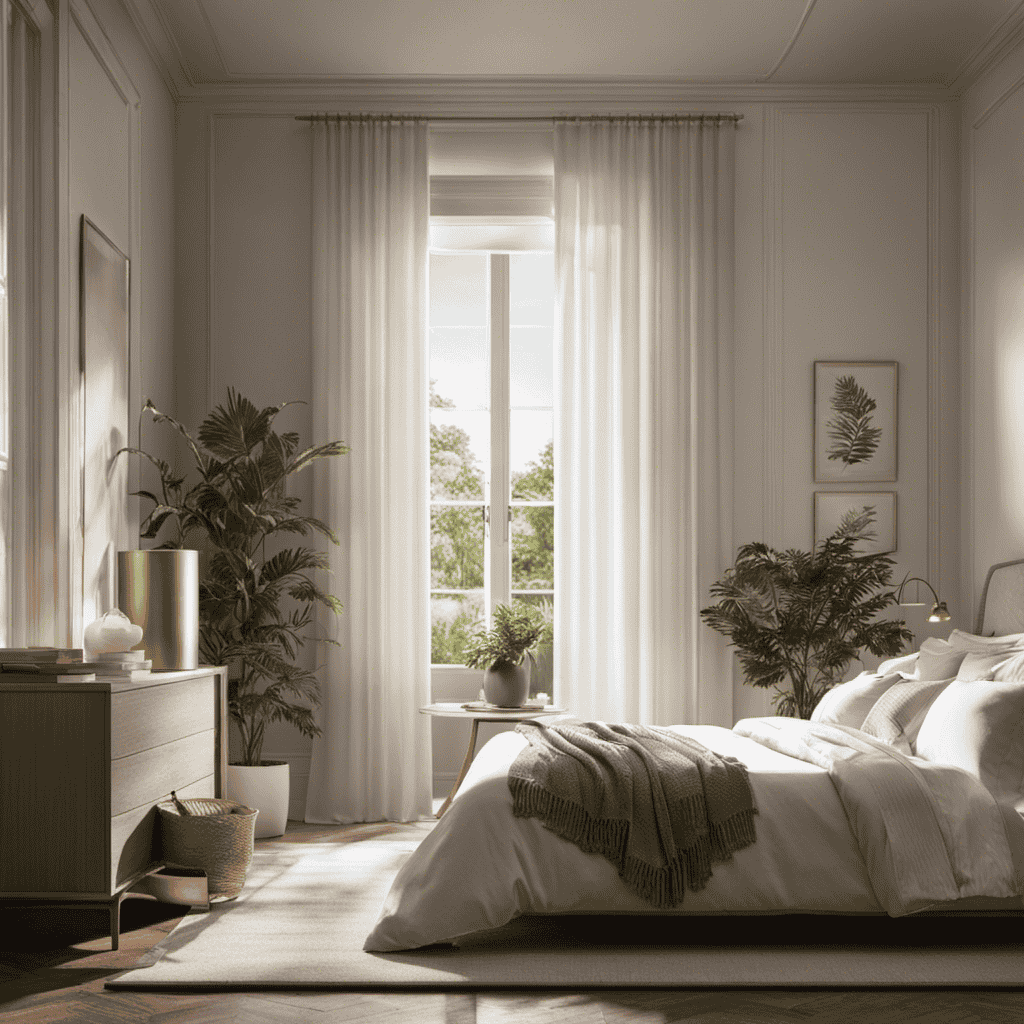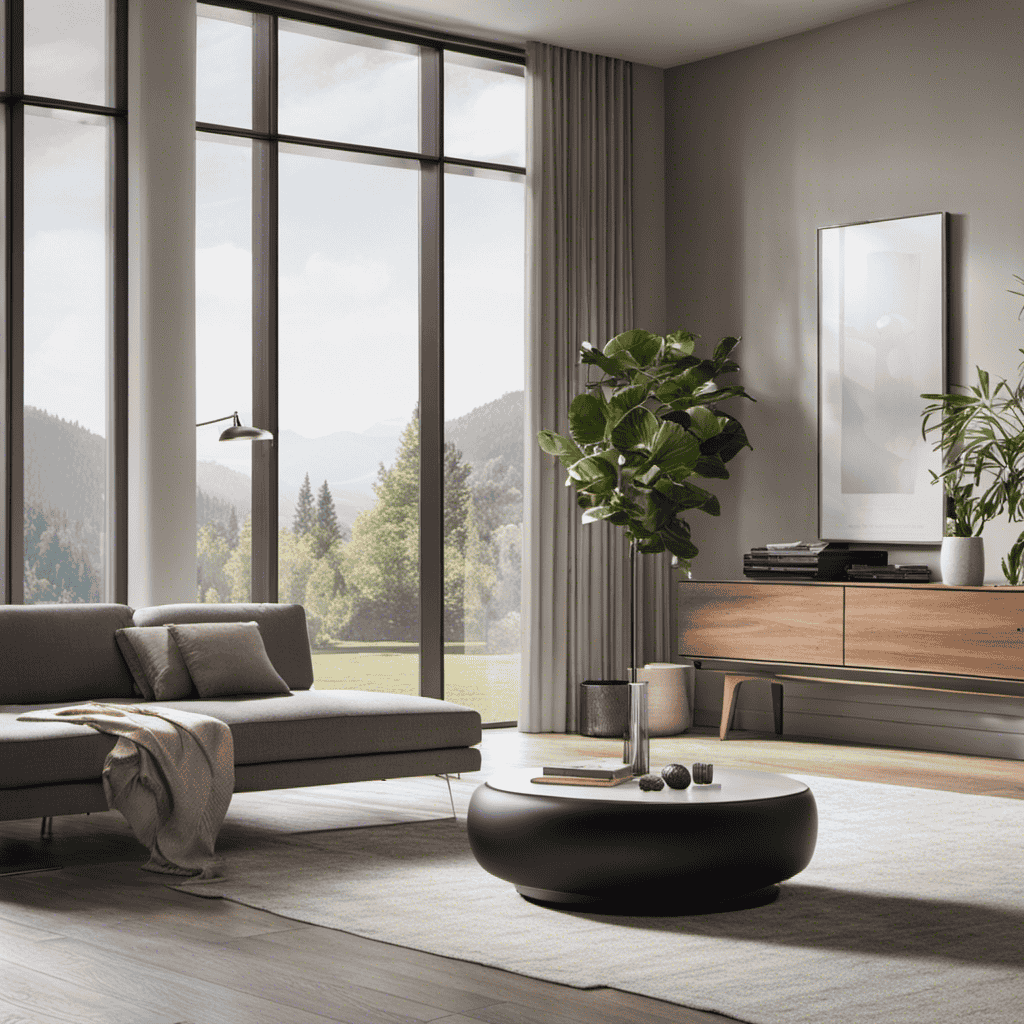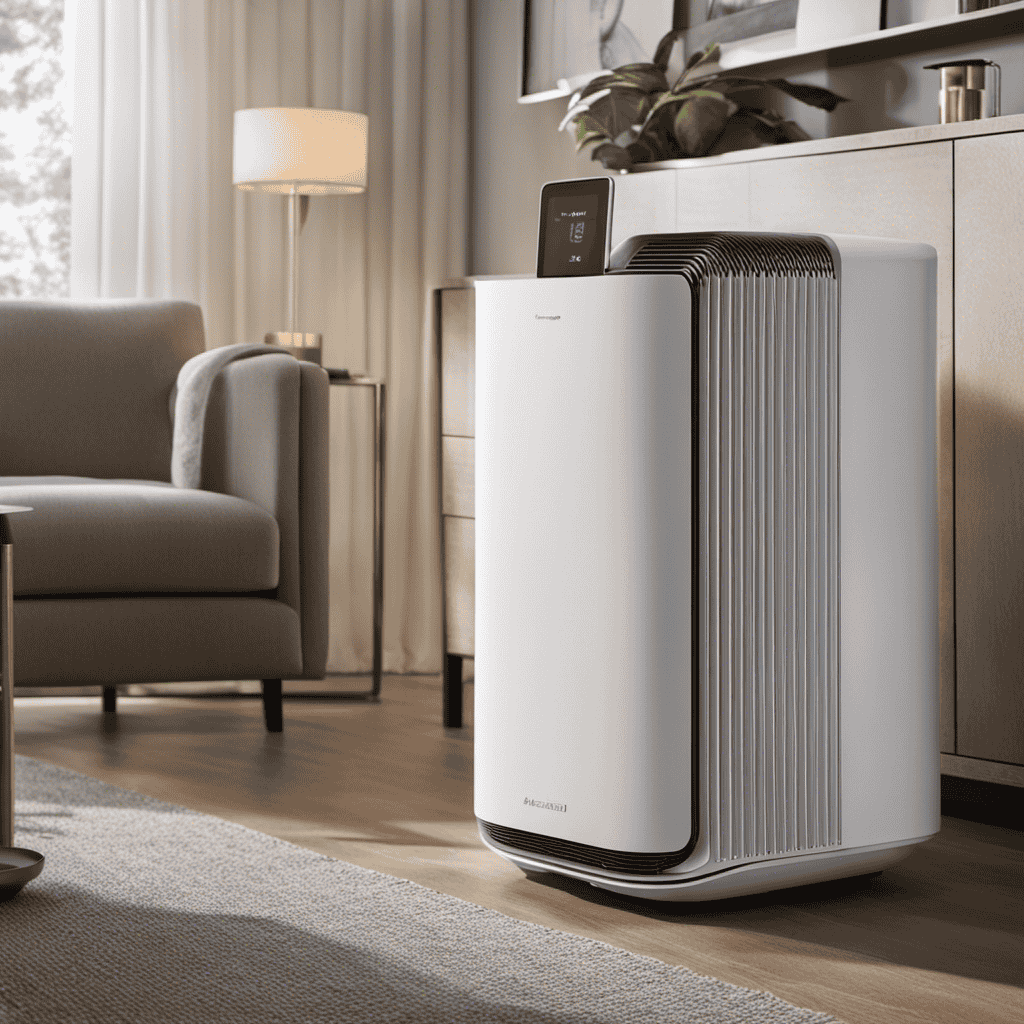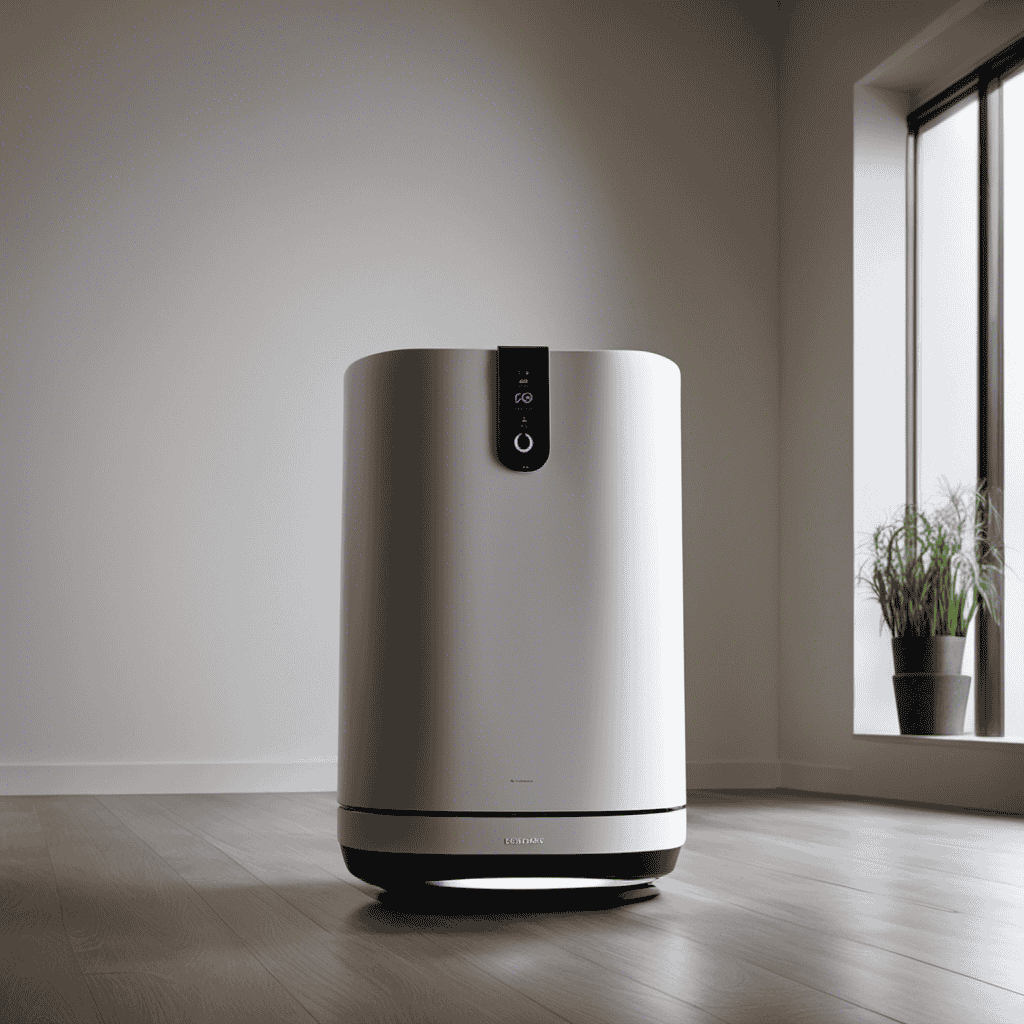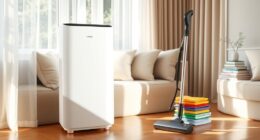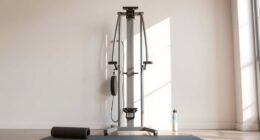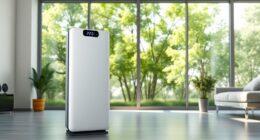I have always held the belief that clean air is crucial for a healthy and comfortable living space. This is why I was interested in gaining more insights about pre filters in air purifiers.
In this article, I’ll break down the purpose of a pre filter, how it works, and the different types available. We’ll also explore the benefits of using a pre filter and important factors to consider when choosing one.
Plus, I’ll share some maintenance tips and debunk common misconceptions. Let’s dive in and discover the power of pre filters in air purifiers.
Key Takeaways
- Pre filters in air purifiers capture larger particles such as dust, pet hair, and pollen.
- They prolong the life of the main filter and reduce the frequency of filter replacements, saving money in the long run.
- Pre filters enhance the overall performance of the air purifier and improve the overall air quality by reducing dust and allergens in the air.
- They alleviate symptoms for individuals with allergies or asthma and create a healthier living environment.
Purpose of a Pre Filter in Air Purifier
The purpose of a pre filter in my air purifier is to capture larger particles and prolong the life of the main filter. Pre filters are an essential component of air purifiers, as they play a crucial role in enhancing the overall performance of the device.
One of the main advantages of pre filters is their ability to capture larger particles such as dust, pet hair, and pollen. These particles, if left unfiltered, can clog the main filter quickly, reducing its efficiency and lifespan. By capturing these larger particles, the pre filter prevents them from reaching the main filter, thus reducing the frequency of filter replacements and saving money in the long run.
Moreover, pre filters also have a significant impact on the performance of the air purifier. By removing larger particles, they allow the main filter to focus on capturing smaller particles such as bacteria, viruses, and volatile organic compounds (VOCs). This ensures that the air purifier operates at its optimum level, providing cleaner and healthier air for me to breathe.
How a Pre Filter Works in Air Purifiers
One way an air purifier pre filter functions is by capturing larger particles before they reach the main filter. This is one of the key benefits of having a pre filter in an air purifier. By trapping these larger particles, such as dust, pet hair, and pollen, the pre filter helps to prolong the life and efficiency of the main filter. This means that the main filter will not get clogged as quickly, allowing it to effectively capture smaller particles like bacteria, viruses, and allergens.
In terms of maintenance, the pre filter is relatively easy to clean or replace. Most pre filters are washable, which means you can simply rinse them under running water to remove the trapped particles. Some air purifiers even come with indicator lights that tell you when it’s time to clean or replace the pre filter. Regular maintenance of the pre filter ensures that it continues to function optimally and prolongs the overall lifespan of the air purifier.
Understanding how a pre filter works and the benefits it provides is essential when choosing an air purifier. Now, let’s explore the different types of pre filters used in air purifiers and how they differ in their filtration capabilities.
Types of Pre Filters Used in Air Purifiers
When it comes to air purifiers, understanding the different types of pre filters is essential.
Common pre filter types include activated carbon filters, HEPA filters, and washable foam filters.
These pre filters play a crucial role in trapping larger particles like dust, pet dander, and pollen before the air passes through the main filter, enhancing the overall effectiveness of the air purifier.
Regular maintenance of pre filters is necessary to ensure optimal performance, as they can become clogged over time and affect the airflow.
Cleaning or replacing these pre filters as recommended by the manufacturer will help maintain the air purifier’s efficiency and prolong its lifespan.
Common Pre Filter Types
There are various common pre filter types used in air purifiers. These pre filters play a crucial role in enhancing the efficiency and lifespan of the air purifier.
Here are three types of pre filters commonly found in air purifiers:
-
Mesh Pre Filters: These filters are made of a fine mesh material that effectively captures larger particles such as dust, pet hair, and lint. They act as the first line of defense, preventing these particles from clogging the main filter.
-
Foam Pre Filters: Foam pre filters are designed to capture smaller particles like pollen and mold spores. They have a porous structure that allows for better airflow while providing excellent filtration.
-
Carbon Pre Filters: These pre filters contain activated carbon, which helps in capturing and neutralizing odors, chemicals, and volatile organic compounds (VOCs). They are particularly beneficial for individuals with allergies or sensitivities.
To ensure optimal performance, regular maintenance of the pre filters is essential. This involves cleaning or replacing the pre filters as recommended by the manufacturer. By doing so, you can enjoy the benefits of improved air quality and prolong the lifespan of your air purifier.
Pre Filter Effectiveness
To ensure your air quality is improved and your device lasts longer, it’s crucial to regularly maintain and clean the pre filters as recommended by the manufacturer. Pre filters play a vital role in the effectiveness of an air purifier. They are designed to capture large particles such as dust, pet hair, and pollen, preventing them from reaching the main filter. This not only prolongs the life of the main filter but also enhances the overall efficiency of the air purifier. Pre filters are typically made from materials like foam, activated carbon, or polyester. Unlike the main filter, pre filters are cheaper and easier to replace. They act as a first line of defense, capturing larger particles before air passes through the main filter, improving the air quality in your home or office.
| Pre Filter Materials | Pre Filter vs. Main Filter |
|---|---|
| Foam | Removes large particles |
| Activated Carbon | Absorbs odors and gases |
| Polyester | Traps pet hair and dander |
Maintenance of Pre Filters
Regularly maintaining and cleaning the pre filters is crucial for improving air quality and extending the lifespan of your device. Neglecting to clean the pre filters can result in reduced efficiency and performance of your air purifier. Here are some maintenance tips and cleaning techniques to ensure optimal functionality:
- Vacuum the pre filters regularly to remove larger particles and debris.
- Wash the pre filters with mild soap and water every three to six months, depending on usage.
- Allow the pre filters to completely dry before reinserting them into the air purifier.
By following these maintenance tips and cleaning techniques, you can ensure that your pre filters are effectively capturing airborne contaminants and improving the overall air quality in your home or office.
Remember to consult the manufacturer’s instructions for specific cleaning recommendations tailored to your air purifier model.
Benefits of Using a Pre Filter in Air Purifiers
Using a pre filter in air purifiers can provide several benefits. The primary advantage is that it helps to extend the lifespan of the main filter. The pre filter acts as a barrier, capturing larger particles such as dust, pet hair, and lint before they reach the main filter. By removing these larger particles, the pre filter eases the workload of the main filter, allowing it to focus on capturing smaller particles like allergens, smoke, and bacteria. This not only helps the main filter last longer but also ensures that it performs at its best efficiency.
Another benefit of using a pre filter is that it improves the overall air quality in your home. The pre filter’s ability to trap larger particles prevents them from circulating in the air, reducing the amount of dust and allergens you breathe in. This can be particularly beneficial for individuals with allergies or asthma, as it helps to alleviate symptoms and create a healthier living environment.
In terms of maintenance, pre filters are relatively easy to clean or replace. Most pre filters can be washed and reused, while others may need to be replaced every few months. Regular maintenance of the pre filter ensures that it continues to function effectively, prolonging the life of both the pre filter and the main filter.
Factors to Consider When Choosing a Pre Filter for Your Air Purifier
When selecting a pre filter for your air purifier, there are several important factors to consider.
First, you’ll want to think about the filter’s lifespan and efficiency. This will determine how long the filter will last and how effectively it can remove particles from the air.
Additionally, it’s crucial to ensure that the pre filter is compatible with your specific air purifier model. This ensures optimal performance and prevents any compatibility issues.
Lastly, don’t forget to take into account the maintenance and replacement requirements of the pre filter. Regular cleaning and timely replacement are essential to maintain the air purifier’s effectiveness in improving indoor air quality.
Filter Lifespan and Efficiency
The pre-filter’s lifespan and efficiency can vary depending on the air purifier model. It is important to consider these factors when choosing an air purifier. Here are some key points to keep in mind:
-
Filter lifespan: The lifespan of the pre-filter can range from a few months to a year, depending on the quality and usage. Regularly replacing the pre-filter is crucial to maintain the effectiveness of the air purifier.
-
Efficiency: The efficiency of the pre-filter determines its ability to capture larger particles such as dust, pet hair, and pollen. A high-efficiency pre-filter can significantly improve the overall performance of the air purifier.
-
Maintenance: Proper maintenance, such as regular cleaning and replacing of the pre-filter, is essential to ensure optimal performance and longevity. Refer to the manufacturer’s guidelines for specific instructions on maintenance.
Compatibility With Purifier
One important factor to consider is whether the pre-filter is compatible with the model of air purifier you have. Compatibility testing ensures that the pre-filter will fit properly and function effectively within your air purifier.
It is important to check the specifications of your air purifier and compare them with the pre-filter options available. A compatible pre-filter will ensure optimal performance and efficiency in capturing larger particles like dust, pet hair, and pollen. It will also extend the lifespan of the main filter by reducing its workload.
To evaluate the performance of the pre-filter, you can look for customer reviews and ratings, as well as any independent performance evaluations conducted by reputable organizations. Understanding the compatibility and performance of the pre-filter is crucial for maintaining clean, healthy air in your home.
Now, let’s move on to the next section about maintenance and replacement.
Maintenance and Replacement
To keep your home’s air clean and fresh, it’s important to regularly maintain and replace the pre-filter. The pre-filter is the first line of defense in an air purifier, capturing larger particles like dust, pet hair, and lint before they reach the main filter.
Here are some maintenance tips to ensure your pre-filter functions optimally:
- Vacuum or brush the pre-filter every 2-3 weeks to remove accumulated debris.
- Check the pre-filter for signs of wear or damage, and replace if necessary.
- Follow the manufacturer’s recommendations for the pre-filter lifespan and replacement schedule.
Maintenance Tips for Pre Filters in Air Purifiers
Make sure you regularly clean and replace your pre filters in air purifiers to maintain their efficiency. Cleaning your pre filters is a crucial step in ensuring that your air purifier functions optimally. Over time, these filters can become clogged with dirt, dust, and other airborne particles, which can hinder their ability to trap pollutants effectively.
To clean your pre filter, gently remove it from the air purifier and use a vacuum cleaner or soft brush to remove any loose debris. If the filter is heavily soiled, you may need to wash it with mild soap and water, making sure to let it dry completely before reinstalling it.
It is also important to replace your pre filters periodically, as they can become less effective over time. The frequency of replacement will depend on factors such as the air quality in your area and the usage of your air purifier. Be sure to check the manufacturer’s guidelines for recommended replacement intervals.
By regularly cleaning and replacing your pre filters, you can ensure that your air purifier continues to provide clean and healthy air for you and your family.
Now that you understand the importance of cleaning and replacing pre filters in air purifiers, let’s address some common misconceptions about these filters.
Common Misconceptions About Pre Filters in Air Purifiers
Contrary to popular belief, regular cleaning and replacement of pre filters in air purifiers is essential for maintaining optimal air quality. Many people have misconceptions about pre filters and their importance in air purifiers. Here are three common misconceptions debunked:
-
Pre filters are not necessary because the main filter does all the work. While it is true that the main filter in an air purifier is responsible for capturing smaller particles, pre filters play a crucial role in trapping larger particles like dust, pet hair, and lint. By preventing these larger particles from reaching the main filter, pre filters help prolong its lifespan and maintain its efficiency.
-
Pre filters only need to be cleaned or replaced once a year. This is not accurate. The frequency of cleaning or replacing pre filters depends on various factors such as the air quality in your environment, the amount of pollutants present, and the type of air purifier you have. It is recommended to check the manufacturer’s instructions for guidance on how often to clean or replace pre filters.
-
Pre filters are not worth the investment. Some may think that pre filters are an unnecessary expense. However, investing in pre filters can actually save you money in the long run. By keeping the main filter cleaner for longer, pre filters increase its lifespan and reduce the need for frequent replacements. Moreover, pre filters help maintain optimal air quality by capturing larger particles, ensuring that your air purifier functions efficiently.
Comparing Pre Filters to Other Filtration Technologies in Air Purifiers
When comparing different filtration technologies, you may find that pre filters offer distinct advantages over other options. Pre filters are an essential component of air purifiers that help improve the overall efficiency of the device.
These filters are designed to capture larger particles such as dust, pet hair, and pollen, preventing them from clogging the main filter and reducing its lifespan. By trapping these larger particles, pre filters extend the life of the main filter, saving you money on filter replacements in the long run.
In addition to prolonging the lifespan of the main filter, pre filters also enhance the overall air purifier efficiency. By removing larger particles, they allow the main filter to focus on capturing smaller, more harmful pollutants like bacteria, viruses, and fine particulate matter. This ensures that the air you breathe is cleaner and healthier.
Furthermore, pre filters are often washable or vacuumable, making them easy to maintain. By regularly cleaning these filters, you can maintain the efficiency and performance of your air purifier without the need for frequent filter replacements.
Overall, when considering filtration technologies for your air purifier, pre filters offer significant advantages in terms of efficiency, cost savings, and maintenance. They play a crucial role in enhancing the overall performance of the device and ensuring that the air in your home is clean and free from harmful pollutants.
Frequently Asked Questions
Can I Use an Air Purifier Without a Pre Filter?
Yes, you can use an air purifier without a pre filter, but it’s not recommended, especially if you have allergies. The pre filter is an important component that captures large particles like dust, pet hair, and pollen. By removing these particles, it helps extend the lifespan of the main filter and improves the overall efficiency of the air purifier.
Using a pre filter in an air purifier has several benefits. It can lead to better air quality, reduced allergens, and a cleaner environment.
How Often Should I Replace the Pre Filter in My Air Purifier?
Replacing the pre filter in your air purifier is important for optimal performance. Regular replacement ensures that the pre filter continues to capture larger particles like dust, pet hair, and pollen, preventing them from clogging the main filter.
The frequency of replacement can vary depending on the manufacturer’s recommendation, but generally, it is recommended to replace the pre filter every 3-6 months. Regular cleaning, such as vacuuming or washing, can also help extend its lifespan and maintain its efficiency.
Can a Pre Filter Remove Odors From the Air?
Yes, a pre filter can effectively remove odors from the air. It traps larger particles like dust, pet hair, and smoke, preventing them from entering the main filter. This improves air quality and prolongs the main filter’s life.
Using a pre filter in an air purifier has several benefits. It enhances odor control, improves filtration efficiency, and reduces the frequency of main filter replacements. This leads to cost savings in the long run.
Are Pre Filters Washable or Disposable?
Pre filters in air purifiers can either be washable or disposable.
Washable pre filters have the advantage of being reusable, saving you money in the long run. They can be easily cleaned and put back into the air purifier.
On the other hand, disposable pre filters offer convenience as they can be easily replaced when they get dirty. This ensures that your air purifier continues to function effectively in removing larger particles from the air.
Is It Necessary to Have a Pre Filter if My Air Purifier Already Has a HEPA Filter?
It’s important to consider the pros and cons of using a pre-filter in conjunction with a HEPA filter in an air purifier.
While a pre-filter can help capture larger particles and extend the lifespan of the HEPA filter, it may not be necessary if your air purifier already has a HEPA filter.
However, using a pre-filter can still provide added protection and improve the overall performance of your air purifier by reducing the workload on the HEPA filter.
Conclusion
In conclusion, a pre-filter in an air purifier is a crucial component. It helps to remove larger particles and extend the lifespan of the main filter. By capturing dust, pet hair, and other debris, the pre-filter ensures that the air purifier operates efficiently and effectively.
It is important to choose a pre-filter that suits your specific needs. Regular maintenance and cleaning are also necessary to ensure optimal performance.
As the saying goes, "An ounce of prevention is worth a pound of cure." Investing in a pre-filter is an excellent preventive measure for cleaner, healthier air.
